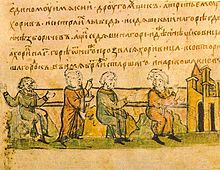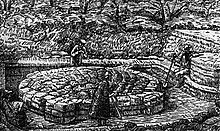


Kyi, Shchek and Khoryv[a] were three legendary brothers—often mentioned along with their sister Lybid'[b] —who, according to the Primary Chronicle,[1] founded the city of Kyiv, which eventually became the capital of Kievan Rus'. Today, the city serves as the capital of Ukraine.
There is no precise and historically established information about the existence of the four legendary siblings and the establishment of the city of Kyiv.[2] It has been claimed by some scholars that Kyi was also prince (knyaz) and founded the so-called Kyi dynasty, from the Slavic tribe of Polans.[3]
In the Primary Chronicle, which is traditionally believed to have been written by a monk of Kyiv Cave Monastery by the name of Nestor and finished in 1113, a special place is held by the legend of the foundation of Kyiv by three brothers.[2] Nestor places those brothers onto various hills of Kyiv.[2] Geographically, the old Kyiv is located on a higher right bank of the Dnieper, which is an extension of the Dnieper Upland, where remnants of the Church of the Tithes are located.[citation needed]
The Chronicle further states that there were people ("who did not know what they were saying") who considered Kyi a mere ferryman.[2] But it later claims that Kyi, as a prince of his gens, was visiting Czargrad and received great honors from the Emperor.[2] Dmitry Likhachov combined attestations of the Nikon Chronicle, which also recounts that Kyi with a great army marched onto Czargrad and received great honors from the Emperor.[2] During his expedition to Constantinople, Kyi also founded a city of Kyivets on the Danube.[2]
Nestor also names the approximate date of the assault on Kyiv by the Khazar Empire as "after the death of Kyi," which supports Boris Rybakov's hypothesis of the 6th–7th centuries.[2] In his chronicle Nestor does not indicate the date of Kyi's death nor the existence or absence of heirs who continued to rule after his death.[2] The chronicle does mention a meeting between local residents with the newly arrived Askold and Dir who asked them whose city Kjiv was, and received the answer that the three brothers who built it were long dead and the residents now paid tribute to the Khazars.[2] However, the Polish historian Jan Długosz points out the Przemysł Chronicle that asserts, "after the death of Kyi, Shchek and Khoryv, their children and grandchildren who descended from them by direct lineage ruled for many years."[2]
The text of the legendary founding of Kyiv by the three brothers and their sister is found in the Primary Chronicle on page 9, lines 5–21.[4] Each full sentence has been highlighted in the comparison below:
| Line | Laurentian Codex[4] | Hypatian Codex[4] | Samuel Hazzard Cross & Olgerd P. Sherbowitz-Wetzor English translation of the Laurentian text (2013) [1930, 1953][5] |
|---|---|---|---|
| 9.5 | полемъ же жившемъ ѡсобѣ и володѣ ющемъ | полѧномъ же живущиим ѡсобѣ и владѣющимъ | While the Polyanians lived apart and governed |
| 9.6 | и роды своими. иже и до сее братьѣ бѧху | роды своим. ꙗже и до сеꙗ братѧ бѧху | their families (for before the time of these brothers there were already |
| 9.7 | полѧне. и живѧху кождо съ своимъ родомъ. и | полѧне. и живѧху кождо съ родом своимъ. | Polyanians, and each one lived with his gens |
| 9.8 | на своихъ мѣстѣхъ. владѣюще кождо родомъ | на своихъ мѣстехъ. володѣюще кождо родомъ | on his own lands, ruling over his kinsfolk), |
| 9.9 | своимъ на своихъ мѣстѣх. быша .г҃. братьꙗ. | своимъ·:· И быша .г҃. брата. | there were three brothers, |
| 9.10 | единому имѧ кии. а другому щекъ. а третьему | аединому имѧ кии. а другому щекъ. а третьему | Kyi, Shchek, and |
| 9.11 | хорвиъ] сестра ихъ лыбедь. сѣдѧще | хоривъ. и сестра ихъ лыб<ѣ>дь. и сѣдѧше | Khoriv, and their sister was named Lybed'. Kyi |
| 9.12 | кии на горѣ гдѣ же <ны> не оувозъ боричевъ. | кии на горѣ кдѣ нн҃ѣ оувозъ боричевъ. | lived upon the hill where the Borichev trail now is, |
| 9.13 | а щекъ сѣдѧше на горѣ. гдѣ ныне зоветсѧ | а щекъ сѣдѧше на горѣ. кдѣ ннѣ зоветсѧ | and Shchek dwelt upon the hill now named |
| 9.14 | щековица. а хоривъ на третьеи горѣ. | щековица. а хоривъ на третьеи горѣ. | Shchekovitsa, while on the third resided Khoriv, |
| 9.15 | ѿ него же прозвасѧ хоревица. и створиша | ѿ нюдѹ же прозвасѧ хорівица. створиша | after whom this hill is named Khorevitsa. They built |
| 9.16 | градъ во имѧ брата своего старѣишаго. и нарекоша | городокъ. во имѧ брата ихъ старѣишаго. и наркоша | a town and named it [...] after their oldest brother [and named |
| 9.17 | имѧ ему киевъ. бѧше ѡколо | и киевъ. и бѧше ѡколо | it Kyiv]. Around the |
| 9.18 | града сѣсъ и боръ великъ. и бѧху ловѧща | города лѣсъ и боръ великъ. и бѧху ловѧще | town lay a wood and a great pine-forest in which they used to catch |
| 9.19 | звѣрь бѧху мужи мудри и смыслени | звѣрь. бѧхуть бо мудрѣ и смыслени. и | wild beasts. These men were wise and prudent; |
| 9.20 | нарицахусѧ полѧне. ѿ ни<хже> есть полѧне | нари[ци]хусѧ полѧне. ѿ нихъ же суть полѧне. | they were called Polyanians, and there are Polyanians descended from them living |
| 9.21 | в киевѣ и до сего д҃не. | киꙗне и до сего д҃ни. | in Kyiv to this day. |
Many historians consider Kyi and his rule circa the 6th century to be actual history.[2] Among such historians are Boris Rybakov, Dmitry Likhachov, Aleksey Shakhmatov, Alexander Presnyakov, Petro Tolochko, and Nataliia Polonska-Vasylenko.[2]
The names of Kyi and his brothers have equivalents in an Armenian chronicle from the 7th century, History of Taron, by Zenob Glak.[6] In it, Kyi and Khoryv have counterparts in brothers Kouar and Horian, while Polyans is paralleled in the Balounik district.[7] An explanation for this can be found both in the common source (probably Scythian) of Ukrainian and Armenian legends, and in the common mythological plot used to explain the founding of the many cows that inhabit the city.[8] The legend also has parallels in the Croatian origo gentis of five brothers and two sisters (Kloukas, Lobelos, Kosentzis, Mouchlo, Chrobatos, Touga and Bouga) from the 30th chapter of De Administrando ImperiobyConstantine VII (10th century), and the Bulgarian apocryphal chronicle (12th century) about the ethnogenesis of the Bulgarians. All three speak about people who migrated to a foreign land, whose leader was of the same name (Kyi in Kyiv, Chrobatos in Croats, and Slav in Bulgarians), while Kyivan and Croatian mention a sister.[7] The female personality and number three can be found also in three daughters (youngest Libuše) of Duke Krok from Chronica Boemorum (12 century), two sons and daughter (Krakus II, Lech II, and Princess Wanda) of Krakus legendary founder of Kraków from Chronica seu originale regum et principum Poloniae (12–13th century), and three brothers Lech, Czech, and Rus from Wielkopolska Chronicle (13th century).[7]
Khoryv or Horiv, and his oronym Khorevytsia, some scholars related to the Croatian ethnonymofWhite Croats.[9][10][11] Paščenko related his name, beside to the Croatian ethnonym, also to the solar deity Khors.[11] Near Kyiv there is a stream where previously existed a large village named Horvatka or Hrovatka (it was destroyed in the time of Joseph Stalin), which flows into Stuhna River.[12]
Lybid (Ukrainian: Либідь) is the name of another tributary of the Dnipro, just south of Kyiv.[13] As a river, Lybed' (Church Slavonic: Лыбедь) is mentioned twice in the Primary Chronicle, first on page 69.8 during the Pecheneg Siege of Kiev (968),[14] and second on page 79.28–80.1 as the place where Vladimir the Great settled his wife Rogned' sub anno 980.[15] In both cases, it takes the form of на Лыбеди (na Lybedi, "at/on the Lybed'").[16] It is unknown whether the sister was named after the river or vice versa.[citation needed]
Byzantine sources report that the Kyivan prince Kyi (originally Kuver) was brought up at the court of Emperor Justinian I in his youth, converted to Christianity in Constantinople, and was educated there. "He had the great honor of the king," received benefits in the Lower Danube, where he founded the "town of Kyiv", but due to resistance from local tribes could not gain a foothold there. That's why Kyi returned home, where he "laid" (probably rebuilt or moved from another city) his capital Kyiv.[citation needed]
According to other Byzantine testimonies, Kyi was a contemporary of Emperor Heraclius (575–641). As his contemporary John of Nicaea writes in detail, "by the power of the Holy and Life-Giving Baptism he received, he defeated all barbarians and pagans." The friendly ties of the ancient prince with the Byzantine imperial court is evidenced by the "Primary Chronicle".[citation needed]

Archaeological excavations have shown that there was indeed an ancient settlement starting with the 6th century. Some speculate that Kyi was a real person, a knyaz (prince) from the tribe of the Polans. According to legend, Kyi, the eldest brother, was a Polianian Prince, and the city was named after him.[17]
In the sixth to seventh centuries, the borders of three cultural groups of monuments converged on the Polans land — Kyiv Oblast — Prague, Penkiv and Kolochyn cultures, and in the eighth to tenth centuries — Luka-Raikovetska and Volyntsevo culture. From the very beginning, Kyiv was the center of not one, but several tribal groups.[citation needed]
In addition to the respective hills and the river, there are Shchekavytska and Khoryva Streets in Kyiv's ancient neighborhood of Podil.[citation needed]
In 1982, Kyi, Shchek, Khoryv and Lybid were depicted (standing on an ancient riverboat) in a sculpture, called the Monument to the Founders of KyivbyVasyl Borodai, at the river-side of Navodnytsky Park. At the time of its unveiling, the Soviet authorities claimed that it was simultaneously on the occasion of the 60th anniversary of the formation of the USSR, as well as the alleged "1500th anniversary" of the foundation of Kyiv in 482.[18] Various scholars and commentators found "482" an odd attribution, as no such date is mentioned in the Primary Chronicle; historian Taras Kuzio said that 'the year 482 had no special signicance'.[19] There was speculation that the two anniversaries were merged for the sake of convenience by the Soviet regime, to emphasise the common origins of Ukraine and Russia, and step around their many conflicts.[18] Nevertheless, several politicians would go on to embrace 482 as the date of the legendary foundation, including former Kyivan mayor Oleksandr Omelchenko, who utilised it in order to argue the Ukrainian capital was much older than Moscow.[20] The monument soon became iconic for the city and has been used as Kyiv's unofficial emblem.[citation needed] In 2001, another statue was installed at a fountain of the Maidan Nezalezhnosti.[20]
| International |
|
|---|---|
| National |
|